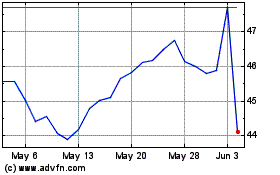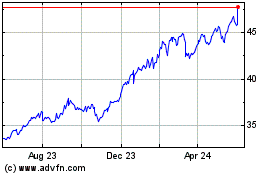Can Rate Hikes Save these Emerging Market ETFs? - ETF News And Commentary
06 February 2014 - 4:00AM
Zacks
The going was extremely tough for emerging market currencies in
2013 with the
WisdomTree Emerging Currency Fund
(
CEW) shedding about 6% of its value. Steeper
decline had been noticed in some currencies like Indian rupee (down
12.6%), Turkish lira (down 18.6%) and South African rand (down
20.4%). The firmness in dollar following the onset of QE taper talk
in 2013 and a general risk off trade created this malaise.
On top of it, all these currencies were down in low-single digit in
the last 15 days of January thanks to the Fed’s long-apprehended
(by investors) decision to scale back QE program from
January. With a bit of risk off trade, Emerging markets seem
to have lost their appeal, especially as U.S. treasury yields
continue to rise. With a possibility of a faster QE trimming in the
course of 2014 and flight of foreign investments from these
developing nations, currencies are likely to weaken further in the
coming days (read: Where Will Global Currency ETFs Go in
2014?).
Rate Hike a Common Resort
Amid such a backdrop, central banks in Turkey and South Africa
stunned investors by raising key rates, to prop up their struggling
currencies on January 28 and 29 respectively. India also joined the
bandwagon around the same time, but the step was taken to contain
its stubbornly high inflation. Whatever be the prime cause, Indian
rate hike should support its ailing currency.
Let’s see in details how proactive the individual central bank was
in shoring up their stressed currencies (read: 3 Currency ETFs
Crushed in Emerging Market Rout):
Turkey
Turkey raised its overnight lending rate sharply on January 28 from
7.75% to 12%, one week repo-rate from 4.5% to 10% and overnight
borrowing rate from 3.5% to 8%. Soon after the announcement,
Turkish currency lira went to rallying and gained as much as 3%,
though it lost some of those gains later.
Higher rates will attract foreign investors to lira-denominated
investments which will in turn boost the value of the currency
(read: Turkey ETF Continues to Struggle as Currency Tumbles).
South Africa
The scenario was little convincing for South Africa which went for
just 50 bps rate hike to 5.5% on January 29 long after 2008.
Notably, the South African rand has depreciated to a five-year low
against the dollar in recent days losing about 25% in the last
eight months. As per analysts, countries like South Africa need to
protect its currency desperately as 40% of its total outstanding
stock of debt is held
by
non-residents. Without such
measure, it will be hard to keep up the inflow of foreign capital
over the long term.
India
On January 28, the Reserve Bank of India (RBI) unexpectedly hiked
its repo rate by 25 bps to 8% in a bid to contain inflation. With
the latest hike, India has raised its repo rate by the same quantum
thrice in the five trailing months (read: A Weaker Rupee--Boon or
Bane for India ETFs?).
Are Rate Hike Measures Justified?
No doubt, rate hike will rein in these countries’ growth rates.
This is surely no good news especially at a moment when growth
rates of emerging nations are slowing and investor focus has
shifted toward developed nations where the economic dynamics are
improving steadily. Quite expectedly, markets of the concerned
nations did not welcome the step on the possibility of sluggish
growth. A substantial fall in ETFs related to the respective
countries affirms this fact.
Investors should note that the only pure-play on Turkey
iShares MSCI Turkey Investable Market ETF
(
TUR) slumped 3.24% at the close of January 29,
the biggest South African fund
iShares MSCI South Africa
ETF (EZA)
tumbled 3.79% while major Indian ETFs like
WisdomTree India Earnings Fund
(
EPI),
iShares India 50
(
INDY),
iShares MSCI India
(
INDA) and
PowerShares India
(
PIN) lost 1.61%, 2.25%, 1.91% and 2.20%
respectively.
Bottom Line
Such measures might help in boosting investors’ confidence in the
emerging markets, though at the cost of
reduced growth, especially in the current environment when emerging
currency devaluation is a large factor.
On a positive note, even after being reduced, growth rates are
still decent at about 4% to 5% in emerging nations, better than
many fast-growing developed countries.
However, barring some initial euphoria, Turkish lira and South
African rand failed to hold up the rally versus the greenback. With
the Fed announcing another round of $10 billion cut in the QE
program, the USD has once again taken the center stage.
In a nutshell, the greenback will rule the year 2014. Apart from
the dollar, no other currency is promising outright appreciation
relative to the USD. It is advisable to stave off the
emerging market currency exposure. Investors with high risk
appetite wanting to tap these markets, should be extremely choosy
and take closer look at each and every Fed move.
Want the latest recommendations from Zacks Investment Research?
Today, you can download
7 Best Stocks for the Next 30
Days. Click to get this free report >>
WISDMTR-EMG CUR (CEW): ETF Research Reports
WISDMTR-IN EARN (EPI): ETF Research Reports
ISHARS-S AFRICA (EZA): ETF Research Reports
ISHARS-M INDIA (INDA): ETF Research Reports
ISHARS-SP INDIA (INDY): ETF Research Reports
ISHRS-MSCI TURK (TUR): ETF Research Reports
To read this article on Zacks.com click here.
Zacks Investment Research
Want the latest recommendations from Zacks Investment Research?
Today, you can download 7 Best Stocks for the Next 30 Days. Click
to get this free report
WisdomTree India Earnings (AMEX:EPI)
Historical Stock Chart
From Feb 2025 to Mar 2025

WisdomTree India Earnings (AMEX:EPI)
Historical Stock Chart
From Mar 2024 to Mar 2025
